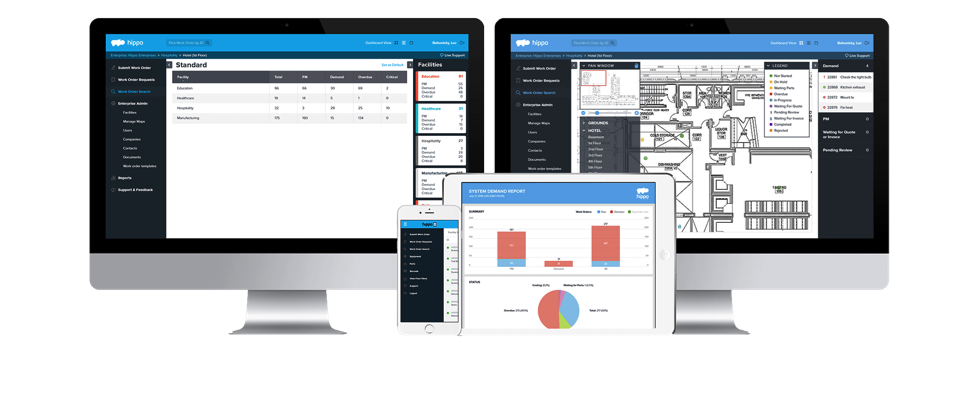For starters, all maintenance-related data will be stored on a computer. In the days of old, managers would record all data in logs and journals. Nowadays, enterprise-level systems cannot afford to run such inefficient practices and computerised entries are the way to go. The gradual migration from paper journals to computers took place between the 80s and 90s. It is imperative to be able to generate the most effective, reliable, and accessible CMMS data, and computers do precisely that.
As far as maintenance goes, this cog in the wheel refers to the work orders that are routinely undertaken by companies. These are wide-ranging and include mechanical fixes, compliance testing, routine inspections, replacement parts etc. Computers as we know them, are not yet sufficiently advanced to conduct these necessary maintenance repairs, tests, and checks.
What they can do however is log the data in order of priority, provide for the necessary inventory (available resources), and ensure that the right work orders are assigned to the right people at the right time. By working with the most reliable CMMS systems, technicians and other professionals can spend their time on actual maintenance work and not ruffling through papers in search of priority work orders, resources, and allocations.
The next step is the management of all CMMS operations. Management is regarded as the most important component of the entire CMMS function. By providing a comprehensive list of work orders, inventory levels, reports, available personnel, et al., management can effectively control the maintenance work orders. With big organisations running a myriad of daily tasks, things can quickly spiral out of control and important repairs could be buried under mounds of paperwork.
Not so with CMMS software solutions. They provide maximum efficiency, effectiveness and priority vis-à-vis maintenance and work orders. The powerful processing capabilities of computerised maintenance management systems guarantee that management will have a much easier time controlling day-to-day activities. This also allows for clarity in decision-making, effective control of work orders, and the maintenance of high standards.
The final component of a CMMS solution is the actual system. There is a wide range of high-quality CMMS solutions that are available to clients, and some are better suited to specific maintenance tasks than others. All CMMS solutions are expressly designed to allow the user to achieve a specific set of results. They are geared towards cost savings, time savings, and efficiency.
How does a CMMS software really work?
CMMS solutions are widespread, including those designed for preventive maintenance, work orders, parts inventory, inventory tracking, reports, and work requests. Depending on what your specific needs are, a CMMS solution can really assist you in driving down costs, improving the efficiency of operations, and maximising effective management of your maintenance solutions. For example, schedules could be set up by the relevant manager or admin staff by time, task, class, shop or project. This software is powerful enough to transcribe all maintenance work requests to a calendar that is easily edited by those with the authority to do so.
The benefits of using a CMMS solution span far and wide. For example, a company could effectively schedule additional maintenance work order requests on AC units that typically work overtime during summer. All types of maintenance requests can easily be accommodated on these powerful CMMS solutions, and they save companies time, money, and effort in a big way. The many benefits of using these solutions include reduced downtime, lower maintenance costs, and lower levels of machinery replacement.
It can be exceptionally risky changing from an outdated system to a brand-new computerised maintenance management software. However, there are affordable solutions out there that make the implementation and adoption of new software as painless as possible. The mark of an effective CMMS solution is its adoption rate. They have to be user-friendly, inexpensive and easy to maintain. That’s why it is necessary to simplify complex operations by adopting a user-friendly interface, replete with all the necessary training and support options. Flexibility, customization, transparency, and credibility are the hallmarks of the world’s finest CMMS solutions.
What CMMS features should you be looking for?
Simplicity trumps complexity any day of the week. Therefore, a CMMS solution should always make things as clutter free, easy to use, and simple as possible. Companies should be able to track maintenance orders, detail inventory, and allocate assets in the most painless way possible. Real-time updates of maintenance requests ensure that there are no duplicate work orders, missing work orders, inefficiently assigned resources, or other errors.
The best CMMS systems are geared towards extending the lifespan of all company assets. By ensuring the proper care and maintenance of all respective resources, cost savings are inevitable. It’s all about the right documentation and how to access it. This includes manuals, files, images, and the like. As part of a broader inventory management system, your CMMS is able to customise reports, provide accurate information in a database, and offer workable solutions to complex challenges.
With today’s tech-savvy, mobile generation of experts, mobile functionality is a must. Smartphones, tablets, and phablets should be equipped with powerful CMMS features to manage work orders effectively on the go. There are many other features that CMMS systems are suited for, including vendor management, resource management, costing and control. The interactive nature of the CMMS solution makes navigation through the entire system as simple as possible. Equipment needs to be effectively maintained for maximum efficiency. The only way to perform such complex tasks is a powerful CMMS software.










